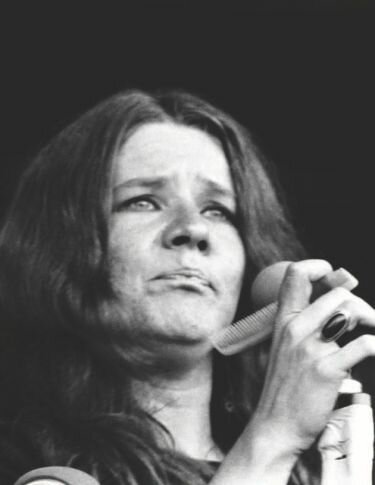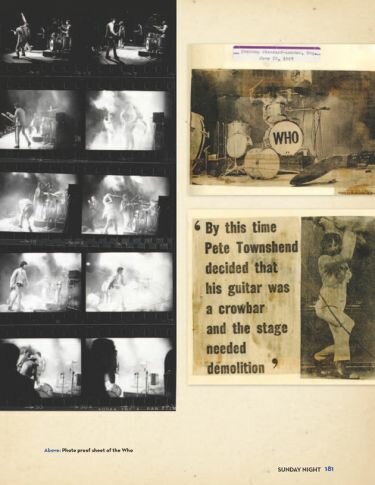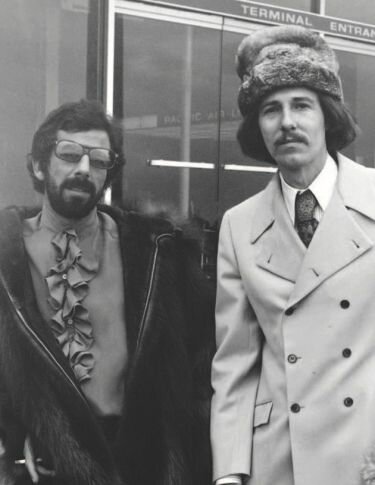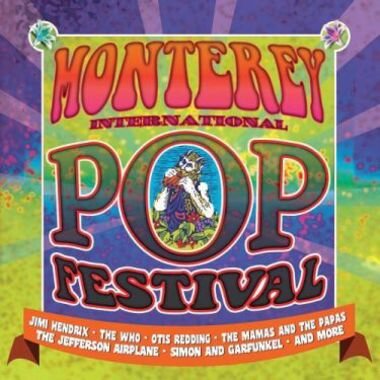
Harvey and Kenneth Kubernik's lavish new document of the Monterey International Pop Festival, A Perfect Haze, brings to life in word and image the most significant festival in rock 'n' roll history.
Epitomizing the Summer of Love, Monterey brought together Grateful Dead, Jimi Hendrix, Jefferson Airplane, Janis Joplin, The Mamas and the Papas, Otis Redding, Ravi Shankar, Simon and Garfunkel, The Who, and many many others for three days of musical and cultural magic June 16-18, 1967.
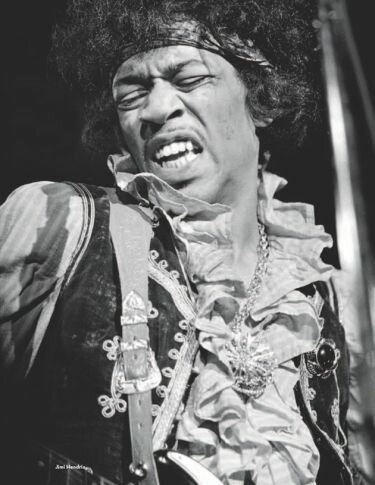 The Kubernik's recreate the setting and the vibe with a thousand telling details and interviews with virtually everyone and their mothers associated with the show (other than the dear departed) including show producers Lou Adler and John Phillips; Michelle Phillips; Pete Townshend; Roger Daltrey; Bob Weir; Ravi Shankar; filmmaker D.A. Pennebaker; Derek Taylor; Andrew Loog Oldham; Steve Cropper; Booker T. Jones; photographers Henry Diltz, Elaine Mayes, and Nurit Wilde; and our very own Al Kooper, who was a stage manager for the event as well as a performer.
The Kubernik's recreate the setting and the vibe with a thousand telling details and interviews with virtually everyone and their mothers associated with the show (other than the dear departed) including show producers Lou Adler and John Phillips; Michelle Phillips; Pete Townshend; Roger Daltrey; Bob Weir; Ravi Shankar; filmmaker D.A. Pennebaker; Derek Taylor; Andrew Loog Oldham; Steve Cropper; Booker T. Jones; photographers Henry Diltz, Elaine Mayes, and Nurit Wilde; and our very own Al Kooper, who was a stage manager for the event as well as a performer.
The book is stuffed with candid and official photographs of the people, places, posters, telegrams, legal documents, press releases, and performances that further bring the legend alive. Also included is a fascinating run-down and analysis of every act that performed over the three days, including lists of all performing personnel and songs played.
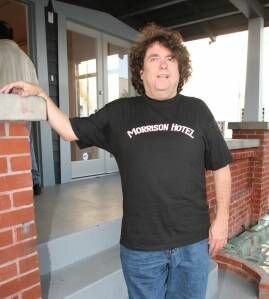 I discussed Monterey and his wondrous book with Harvey Kubernik via email.
I discussed Monterey and his wondrous book with Harvey Kubernik via email.
EO: What is the main source of your personal interest in Monterey International Pop Festival?
Harvey Kubernik: In 1967 I heard about the event on the local AM and FM radio stations in Los Angeles. The Monterey festival was 400 miles from Hollywood.
How did LA vs SF play out?
HK: It's pretty much documented in the book. The "Hollywood" people, the bands and their commercial reality weirded out a lot of the closed-minded Bay area folks. Believe me, most of them wanted to have hits on the AM radio dial. From the bands to the crowd members. If it wasn't for the production acumen of Adler and Phillips and their attention to detail in advance of the dates - can you imagine any other team trying to do this sort of event in a six week period?
Needless to say, all these San Francisco bands and their managers at the time, right after Monterey signed with Hollywood and Southern California-based record labels and many of these anti-Hollywood musicians ended up recording their debut LP's and other albums on Sunset Blvd. at studios like RCA.
How do you think Jefferson Airplane's Surrealistic Pillow would sound if not tracked and mixed in Hollywood?
HK: It was a moment but that moment continues. From the charity foundation to writers and music lovers like myself who were and still informed by some of the ideals and concepts gleaned from Monterey. Adding to the music and recordings millions of people first experienced as a direct result of what was presented that June 1967 weekend in Monterey.
Epitomizing the Summer of Love, Monterey brought together Grateful Dead, Jimi Hendrix, Jefferson Airplane, Janis Joplin, The Mamas and the Papas, Otis Redding, Ravi Shankar, Simon and Garfunkel, The Who, and many many others for three days of musical and cultural magic June 16-18, 1967.
 The Kubernik's recreate the setting and the vibe with a thousand telling details and interviews with virtually everyone and their mothers associated with the show (other than the dear departed) including show producers Lou Adler and John Phillips; Michelle Phillips; Pete Townshend; Roger Daltrey; Bob Weir; Ravi Shankar; filmmaker D.A. Pennebaker; Derek Taylor; Andrew Loog Oldham; Steve Cropper; Booker T. Jones; photographers Henry Diltz, Elaine Mayes, and Nurit Wilde; and our very own Al Kooper, who was a stage manager for the event as well as a performer.
The Kubernik's recreate the setting and the vibe with a thousand telling details and interviews with virtually everyone and their mothers associated with the show (other than the dear departed) including show producers Lou Adler and John Phillips; Michelle Phillips; Pete Townshend; Roger Daltrey; Bob Weir; Ravi Shankar; filmmaker D.A. Pennebaker; Derek Taylor; Andrew Loog Oldham; Steve Cropper; Booker T. Jones; photographers Henry Diltz, Elaine Mayes, and Nurit Wilde; and our very own Al Kooper, who was a stage manager for the event as well as a performer.The book is stuffed with candid and official photographs of the people, places, posters, telegrams, legal documents, press releases, and performances that further bring the legend alive. Also included is a fascinating run-down and analysis of every act that performed over the three days, including lists of all performing personnel and songs played.
 I discussed Monterey and his wondrous book with Harvey Kubernik via email.
I discussed Monterey and his wondrous book with Harvey Kubernik via email.EO: What is the main source of your personal interest in Monterey International Pop Festival?
Harvey Kubernik: In 1967 I heard about the event on the local AM and FM radio stations in Los Angeles. The Monterey festival was 400 miles from Hollywood.
Elliot Mintz on KPFK-FM was giving reports all the time as well as DJ's on KRLA-AM. Phil Proctor of the Firesign Theater was giving news on the airwaves from the gathering.
I was well underage and my mother said, "When you are age 18 and graduate from high school you can go to any music festival you want."
I wasn't bummed out, just made me want to see all these acts in 1968 and '69 when they performed in town. The weekend I graduated high school I saw The Jimi Hendrix Experience at a local festival in Devonshire Downs along with Spirit, The Edwin Hawkins Singers, Ike & Tina Turner and Joe Cocker.
I wasn't bummed out, just made me want to see all these acts in 1968 and '69 when they performed in town. The weekend I graduated high school I saw The Jimi Hendrix Experience at a local festival in Devonshire Downs along with Spirit, The Edwin Hawkins Singers, Ike & Tina Turner and Joe Cocker.
I started organically collecting items from Monterey and attended the 1969 movie premiere of Monterey Pop in Beverly Hills at the Fine Arts Theater. I went to multiple screenings around my after-high school day job. My brother Ken, who co-authored the book with me checked out the movie a bunch of times, too. The movie theater was 25 yards up the street from where our father worked on Wilshire Blvd.
HK: More significant than anyone will ever realize, except for maybe producer Lou Adler. Filmmaker D.A. Pennebaker in the book told me he knew Lou and co-producer John Phillips were hatching an interesting plan when they took the money off the table. As far as the ramifications of Monterey staged as a non-profit event, all I really have to do is point to the ongoing Monterey International Pop Festival Foundation, a music-themed charity endeavor that is in year 44 of operation, and has helped so many people.
Sometime in the early 1980s when I didn't have health insurance and had a real bad sore throat, I went to The Los Angeles Free Clinic for some antibiotics. I noticed there was a wing of the building that was made possible from support from The Monterey International Pop Festival Foundation. This was never lost on me. That place and the San Francisco Free Clinic in 1967 or early '68, right after the concerts, received some of the first grants from the proceeds.
Was this the greatest concert ever?
HK: Possibly. Probably. Depends on what the music does to you in a live setting. However, monitor the 32 acts at Monterey over three days that were booked. And then factor in
the global platform and subsequent media coverage they received from appearing. Outdoor music festival culture was never the same. And the records you heard on the FM dial and then bought for your own record collection were different than the week before.
Please compare and contrast with Woodstock.
HK: Can't really compare or contrast. Monterey was a non-profit adventure. Woodstock was conceived as a way to make a profit. A whole different mindset and karma is attached to Monterey. One was planned in West Hollywood and executed in Northern California. The other happened in New York.
And one of the main investors, producers, of Woodstock saw the movie Monterey Pop and decided to help bankroll Woodstock. Chip Monck did the lights and was heavily involved in the stage design at both venues. At least six of the bands who debuted or performed at Monterey two years later played at Woodstock.
Everything starts in the West.
Only in 2007, after speaking with a booking agent who helped package the Newport '69 in Devonshire Downs festival, two months before Woodstock -- maybe 30,000-40,000 people -- did he tell me he earlier booked a few of the acts for Monterey in 1967. In an interview he discussed how so many agents and managers saw what Lou and John did putting on a non-profit show for an entire weekend, and they all got together and wanted to put something to make a profit.
HK: When I was a teenager I always thought the Jimi Hendrix Experience was it. Mind blowing. Then, I sort of started to feel Janis Joplin with Big Brother & The Holding Company stole the show.
Then over a 25 year period I began to vibe the scene-stealer was Otis Redding with Booker T. & The MGs, and the horn section. This century Ravi Shankar is now emerging as the quintessential performance. Maybe because he brought the East to the West that afternoon. Ken and I just saw him in late-September in L.A. give a recital at age 91.
On the most recent DVD I encourage anyone to go watch Laura Nyro sing "Poverty Train."
Would MIPF have made Beach Boys cooler or would they have made it less cool?
HK: Yes. It would have been even better and way cooler if they played. They were asked and initially on all the advertising. Remember, context is king. If they had gigged, their repertoire would have been pretty much tunes from Pet Sounds and also including selections from the haulted or "landlocked" SMiLE, it would have really positioned them deeper into the emerging FM radio world and listenership.
Then over a 25 year period I began to vibe the scene-stealer was Otis Redding with Booker T. & The MGs, and the horn section. This century Ravi Shankar is now emerging as the quintessential performance. Maybe because he brought the East to the West that afternoon. Ken and I just saw him in late-September in L.A. give a recital at age 91.
On the most recent DVD I encourage anyone to go watch Laura Nyro sing "Poverty Train."
Would MIPF have made Beach Boys cooler or would they have made it less cool?
HK: Yes. It would have been even better and way cooler if they played. They were asked and initially on all the advertising. Remember, context is king. If they had gigged, their repertoire would have been pretty much tunes from Pet Sounds and also including selections from the haulted or "landlocked" SMiLE, it would have really positioned them deeper into the emerging FM radio world and listenership.
I will add, and this is something D.A. Pennebaker told me although it might not be totally accurate, but he has a great memory: he believes the sound board mix he employed for his movie Monterey Pop was mixed by Lou Adler and John Phillips on an eight-track machine that Brian Wilson owned at the time. So, Brian was involved in some technical or spiritual aspect of the festival's audio results. I asked Brian but he could not remember. But he always had the latest sound system around town, even an eight-track in 1966.
How did LA vs SF play out?
HK: It's pretty much documented in the book. The "Hollywood" people, the bands and their commercial reality weirded out a lot of the closed-minded Bay area folks. Believe me, most of them wanted to have hits on the AM radio dial. From the bands to the crowd members. If it wasn't for the production acumen of Adler and Phillips and their attention to detail in advance of the dates - can you imagine any other team trying to do this sort of event in a six week period?
Needless to say, all these San Francisco bands and their managers at the time, right after Monterey signed with Hollywood and Southern California-based record labels and many of these anti-Hollywood musicians ended up recording their debut LP's and other albums on Sunset Blvd. at studios like RCA.
How do you think Jefferson Airplane's Surrealistic Pillow would sound if not tracked and mixed in Hollywood?
What are the significant technical achievements?
HK: Certainly the sound system Adler and the staff made possible at Monterey helped the artists and the audience. I'm sure advances were made for outdoor events that evolved from what was initiated at Monterey in logistics involving sound delivery, monitors, speakers, travel and food arrangements.
Plus, Chip Monck had to invent so many things subject specific to the sound and lighting collaboration. And building a vehicle for sound and light to travel. Until then, many bands and performers had little amps, or played through a house PA or a sound system provided by the show promoter.
In 1971, Chip Monck did the lights for George Harrison & Friends and The Concert For Bangla Desh. Another non-profit event that still helps out the world today.
Sonically and technically, Monterey in 1967 changed the game. And we all get to benefit from it. From Newport '69 at Devonshire Downs in the Northridge area of Southern Califoirnia held in June 1969, to the yearly Coachella festival in California.
HK: It was a moment but that moment continues. From the charity foundation to writers and music lovers like myself who were and still informed by some of the ideals and concepts gleaned from Monterey. Adding to the music and recordings millions of people first experienced as a direct result of what was presented that June 1967 weekend in Monterey.
Al Kooper, who was the assistant stage manager and also played a set at Monterey, made a couple of musical connections in and around his Monterey world that helped him when he formed Blood, Sweat & Tears. Go listen to that debut album.
Things were never the same after that June festival ended. The recording artists began to get more control of their artwork and recordings. I'm sure established record label advances went up for new artists. And concert fees probably were higher in 1968 from 1967, primarily owing to what Monterey put in motion. Then factor in record label executives, like Clive Davis and Joe Smith, who inked bands from seeing them for the first time live.
Things changed quickly. By 1968 all sorts of moments happened that were not what was on display or captured on film at Monterey. Fashion always moves and the music always moves, too.
Steve Cropper told me he was real pleased, now looking back, and glad, that Monterey took place in 1967. Because in April '68 in Memphis, his regional horror was a new reality with the murder of Martin Luther King, Jr. Then in Los Angeles with the murder of Robert F. Kennedy.
The thing is, Monterey never ended. Even Lou mentioned to me since he deals daily with the Monterey Foundation and licensing of items that aid musicians and people, "It's like managing an act."
I see the spirit of Monterey continuing. All the time. This book brings it to a whole new level, augmenting the existing CD soundtracks and the DVD's culled from the original festival.
With all the CD reissues of many of the acts that played at Monterey, coupled with new mono versions of the Mamas and the Papas debut LP in release again, new ears discovering Moby Grape, the increase in people buying vinyl, and all the constant interest around this book and the still glowing Summer of Love mentality, I keep believing it still has a potent spirit. It has become cross-generational. Parents and their kids buying all the products associated with this cosmic and very real deal era will always keep going.

